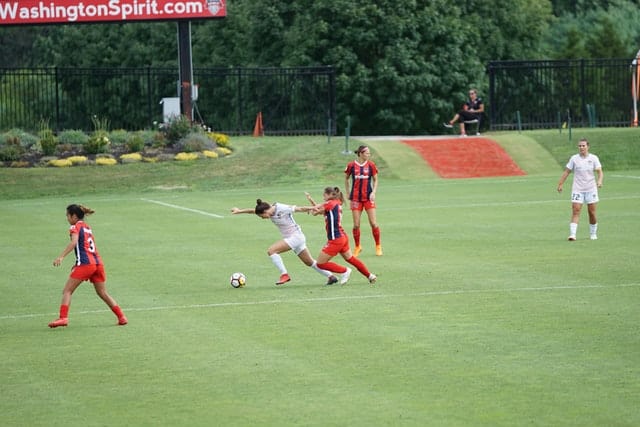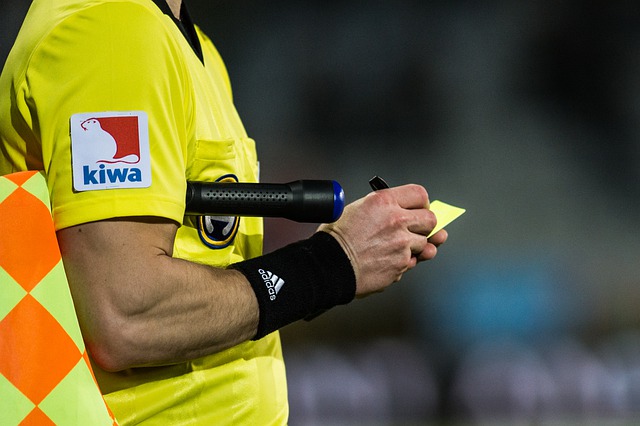Yellow cards in soccer serve as a warning to a player if they break some rules during a soccer match. It is very likely that you see them used in most professional soccer games because yellow cards are very common.
The yellow cards are also one of the fundamentals of the game. If you’ve ever watched a single soccer match, there is a great chance that you have seen at least 1 yellow card (usually 2 or more) during that match.
When I first started watching soccer with that in mind, I couldn’t help but wonder when and how soccer players get yellow cards. If that’s a question of yours, then you’ve come to the right place.
Here is how you get a yellow card in soccer:
1- Wasting time
Unlike in some other sports, the clock does not stop at all during a soccer game. In other words, if the ball goes out of play, the timer of the game keeps going.
This introduces the idea of wasting time when the ball is out of play. For example, if team A is winning the game, then some of their players may try to waste time by taking a lot of time to perform a goal kick, a free kick and so on.
Some coaches even make late substitutions just to waste some seconds before the game ends.
With that said, the referee is required to take action when it becomes very apparent that a player is wasting time.
The referee usually gives a yellow card to any player that attempts to waste the remaining time of the game while the game is not on.
2- Faking injuries
Flopping and pretending to be hurt in soccer is a common theme.
In fact, some people hate soccer just for the amount of dramatic fake injuries that happen during a professional soccer game.
On a positive note, faking injuries in soccer is not allowed at all. The referee is required to give a yellow card to any player that faked their injury to gain an advantage during the game.
While it’s hard for the referee to tell whether the injury was fake or not, if they were 100% sure that it was fake, they will use their yellow card, and sometimes the red card too.
3- Reckless fouls
If any player attempts to tackle their opponent in a reckless way, then the referee will give them a yellow card. Sometimes the referee goes for a direct red card too if the tackle was very dangerous for any of the players.
But in general, reckless tackles lead to a yellow card in soccer.
4- Denying a promising scoring opportunity for your opponent.
If a soccer player commits a foul that doesn’t require a yellow card by itself, but this foul ends up denying a promising scoring opportunity for the opponent, then the referee may decide to give the player a yellow card.

For example, if a midfield player fouls their opponent while they are heading towards the goal with a few of their teammates on their side, then the referee might give this midfield player a yellow card for preventing a promising scoring opportunity in an illegal way.
5- Taking your shirt off during a goal celebration.
There are many soccer players that have celebrated their goals by taking their shirts off. The reasons for why they do that are stated in this article.
However, taking your shirt off for celebration is not allowed by the soccer rules.
The referee is required to give a yellow card to any player that takes their shirt off during a goal celebration.
The referee is also supposed to give a yellow card for the players that cover their head with their shirt as a form of celebrating a goal. The possible reason behind this is that the player might put themselves in danger if they do so.
6- Intentionally breaking the distance rule during a set piece.
During free kicks, corner kicks, and other set pieces, all of the players are required to be a certain distance away from the ball except the player taking the set piece.
If any player intentionally enters the safe area given to the set piece taker, then the referee might punish them with a yellow card.
7- Leaving the field without informing the referee.
The referee should be aware of any player that has left the field for any reason. For example, some players leave the field for medical reasons.
The referee should know who left the field and for what reason, or else the player might get a yellow card.
Also, after the player leaves, they are usually not allowed to get back into the game until the referee signals them to join the game again.
8- Any other unsporting behavior.
If a referee thinks that a player is disrespecting the game then they might give them a yellow card.
If a player attempts to deceive the referee in any way, then they also get a yellow card.
Players also get yellow cards for distracting their opponents and for any other behavior that the referee deems as an unsporting behavior.
CONCLUSION
Yellow cards serve as a warning to the players, and they are usually used in situations where the player breaks the rules not in a severe way. As for breaking the rules in a severe way, the player will immediately get a red card.
We’ve reached the end of this article. If you’d like to read some related articles, then you can learn more about how to get a red card in soccer here.
You can also learn more about how long a yellow card lasts in soccer from this article.

